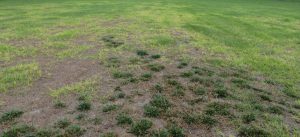Fertilizing your bahiagrass pasture may not be on your mind due to high fertilizer costs, but recent observations indicate that NOT fertilizing may do much harm to your pasture health. We love bahia here in Florida because it establishes well in sandy soils with low fertility, tolerates drought, and can handle continuous grazing. Our relationship with bahiagrass pasture is a two-way street; it will work hard for us if we care for it properly.
How much fertility does the soil need?

Bahiagrass is best adapted to sandy soils and tolerates both low fertility and low pH. It grows well on soils with acidic pH with the target soil pH being 5.5. It survives well on droughty soils. Bahiagrass grows vigorously under high temperature and long days. More than 85% of the production occurs during the six warmest months (April through September). However, if you stack all three of Florida’s poor soil characteristics (sandy soil, low fertility and low pH) against bahiagrass year-after-year, the bahia can “grow” weary (excuse the pun.)
Nitrogen is the nutrient that is most limiting to bahiagrass growth, so producers should first consider needs and how much nitrogen they can afford. Recommendations from the University of Florida suggest a low or medium nitrogen option for grazed, established pastures with further recommendations on P and K based on soil and tissue testing. Soil Test kits and instructions can be obtained from your local IFAS Cooperative Extension Office in your county.
How much grass can I grow?
Annual forage production of bahiagrass ranges from 3,000 to 10,000 lb/acre, depending on soil fertility and moisture conditions. Under highly fertilized management, yields of 12,000–14,000 lb/acre may be obtained. Research reports have shown that rotational grazing will result in greater productivity than continuous stocking (approximately 60 vs. 40 lb/acre of dry matter per day). However, nutritive value is not affected by grazing method. Bahiagrass is a highly persistent grass that has high tiller, rhizome, and root density. The stubble height in midsummer season should be approximately five inches if under continuous stocking. When pastures are overgrazed and close grazing continues, the bahiagrass will become weak and stand loss will eventually occur.

What if poor soil fertility has taken its toll?
Bahiagrass pastures that are well fertilized and growing under optimal conditions will be competitive with weeds. However, most of us use low fertility management, which means weeds will likely become a problem. Most broadleaf weeds can be controlledwith dicamba, 2,4-D, or a combination of the two. Hexazinone is used for smutgrass control, but sprays of this herbicide will need to be kept away from desirable trees, especially oaks.
But it goes much deeper than that, literally!
Research has shown the important role of pastures in sequestering carbon from the atmosphere. Because of the relatively high sequestration rates and extensive area, grazing land represents an important component of terrestrial carbon dioxide (CO2) offset and is a significant sink for long-term carbon sequestration and greenhouse gas mitigation. Carbon sequestration studies have shown that the same management practices that optimize forage for livestock (soil fertilization, proper stocking rates, and rotational grazing) also increase soil carbon concentrations than non-grazed systems. With an extremely deep root system traveling several feet deep, the carbon is stored away in the soil.
Perhaps the take-home message is that PROPER fertilization of bahiagrass pasture might in fact SAVE our environment and our pasture at the same time.
To Read More: Bahiagrass Overview & Management
Carbon Sequestration in Grazing Land
 0
0
